Part 39: February 27 Broadcast

You are listening to BBC radio 4. In an hour we will be looking at some of the best flower parks in London. For the next hour, Professor David Stephenson will be presenting a documentary on the second 80 years war of the eighteenth century. This series will be running every third day, up to 50 episodes. If you want news of the current war in the Middle East please channel in to BBC radio 1.
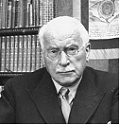 Good evening, and welcome to BBC radio 4. I’m Professor David Stephenson, professor of Dutch historical studies at Cambridge. This is the thirty-ninth part of our 50 episode special on the second 80 years war over Europe. Joining me for these broadcasts are fellow researchers and scholars Doctor Albert Andrews, specialist in German studies from the Berlin academy, Professor Robert Lowe, specialist in French studies at Cambridge, and a graduate student and technical assistant, Anton Thatcher. Last episode, we discussed the beginning of the Polish Crusade.
Good evening, and welcome to BBC radio 4. I’m Professor David Stephenson, professor of Dutch historical studies at Cambridge. This is the thirty-ninth part of our 50 episode special on the second 80 years war over Europe. Joining me for these broadcasts are fellow researchers and scholars Doctor Albert Andrews, specialist in German studies from the Berlin academy, Professor Robert Lowe, specialist in French studies at Cambridge, and a graduate student and technical assistant, Anton Thatcher. Last episode, we discussed the beginning of the Polish Crusade. Polish land forces at the time were outnumbered by the Dutch forces, but unlike the Dutch who were spread over the world, Poland had concentrated their forces along their border around Germany. Their first move was to send a force south, to Munich. This was a major Dutch strongpoint, and taking it would split the Dutch in Vienna from the rest of the Empire.
Polish land forces at the time were outnumbered by the Dutch forces, but unlike the Dutch who were spread over the world, Poland had concentrated their forces along their border around Germany. Their first move was to send a force south, to Munich. This was a major Dutch strongpoint, and taking it would split the Dutch in Vienna from the rest of the Empire.
Defeating Munich would let the Polish army sweep through to Vienna and Italy, blocking a Dutch advance to reinforce from Amsterdam.
 To counter, the Dutch moved troops from Western Germany to Munich and send the Northern Bavarian force to Prague in a counter attack. Due to the nature of the attacks and disposition of troops, the Dutch had far more complex movements. While the Polish could simply march their troops southward, the Dutch had to move troops from all around Europe.
To counter, the Dutch moved troops from Western Germany to Munich and send the Northern Bavarian force to Prague in a counter attack. Due to the nature of the attacks and disposition of troops, the Dutch had far more complex movements. While the Polish could simply march their troops southward, the Dutch had to move troops from all around Europe.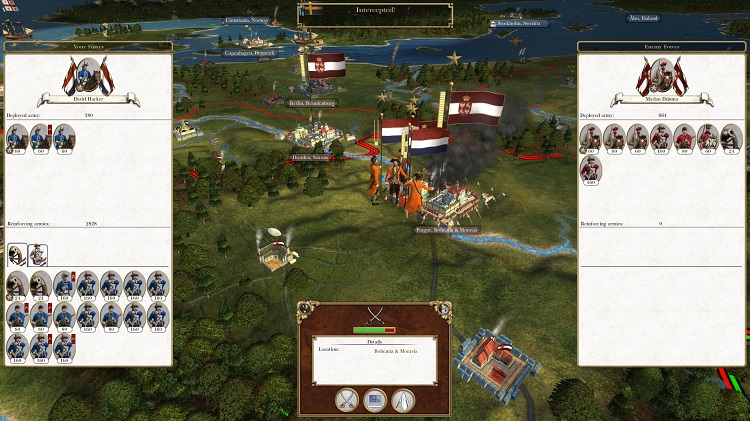
The Dutch could mobilize their troops from many regions, but doing so without leaving weaknesses was often difficult.
 Men from Amsterdam and Cologne moved to counter attack through Hannover into Berlin. Troops were moved from Croatia to Vienna, and the Vienna force moved to check Breslau after the garrison at Prague was encircled.
Men from Amsterdam and Cologne moved to counter attack through Hannover into Berlin. Troops were moved from Croatia to Vienna, and the Vienna force moved to check Breslau after the garrison at Prague was encircled.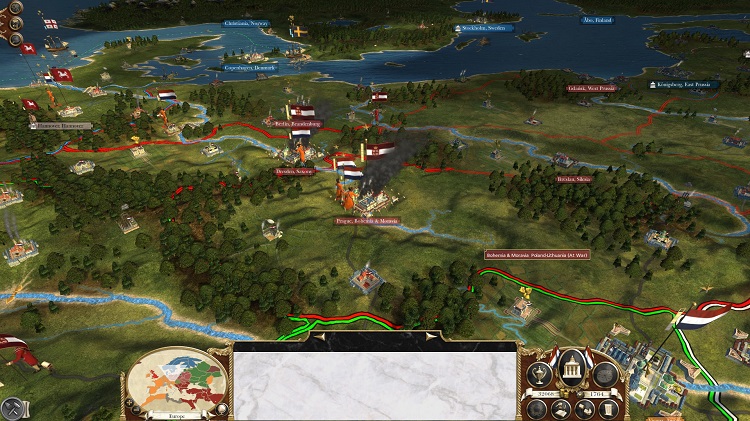
The completion of the Dutch movements into Polish lands.
 To move past Prague, the city had to be sieged, but at the same time, the army had a thousand additional men encamped outside the city, as the city was past capacity for military forces. While Prague was encircled, the Dutch regiment of horse had to intercept and destroy the additional forces to allow the Vienna past to Silesia. Without, the Vienna force would either have to push their way past, or take several months to maneuver around them.
To move past Prague, the city had to be sieged, but at the same time, the army had a thousand additional men encamped outside the city, as the city was past capacity for military forces. While Prague was encircled, the Dutch regiment of horse had to intercept and destroy the additional forces to allow the Vienna past to Silesia. Without, the Vienna force would either have to push their way past, or take several months to maneuver around them.
Before the full deployment, Dutch forces had to clear aside a reinforcing cavalry force around Prague. Regiments of horse led the charge, and were aided by reinforcements from the siege forces.
 The first battle of Prague consisted of a detachment of men from Cologne as well as the regiment of horse, detached from the Munich army. Encamped outside the walls of Prague were only two battalions of foot infantry and a single howitzer. Their main compliment was actually provincial cavalry, as they would be far less useful fighting from within the wall so Prague, the infantry and howitzer were only to stop the Dutch hussars from running their cavalry down.
The first battle of Prague consisted of a detachment of men from Cologne as well as the regiment of horse, detached from the Munich army. Encamped outside the walls of Prague were only two battalions of foot infantry and a single howitzer. Their main compliment was actually provincial cavalry, as they would be far less useful fighting from within the wall so Prague, the infantry and howitzer were only to stop the Dutch hussars from running their cavalry down.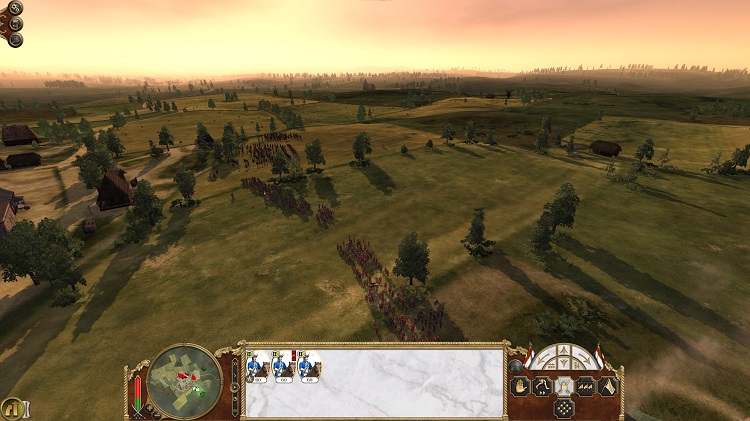
The Polish forces had several battalions of line to fend off a Dutch cavalry force chasing away the Polish cavalry, but they did not have enough to fend off a full assault.
 The Dutch army that came across them managed powerful cavalry charges pushing directly into the Uhlan and provincial cavalry of the Polish army. The impetuous Polish cavalry attacked piecemeal, hoping to delay the Dutch long enough to arrange and prepare their artillery. This led only to the destruction of the Polish cavalry, but the Dutch cavalry was definitely being thinned down.
The Dutch army that came across them managed powerful cavalry charges pushing directly into the Uhlan and provincial cavalry of the Polish army. The impetuous Polish cavalry attacked piecemeal, hoping to delay the Dutch long enough to arrange and prepare their artillery. This led only to the destruction of the Polish cavalry, but the Dutch cavalry was definitely being thinned down.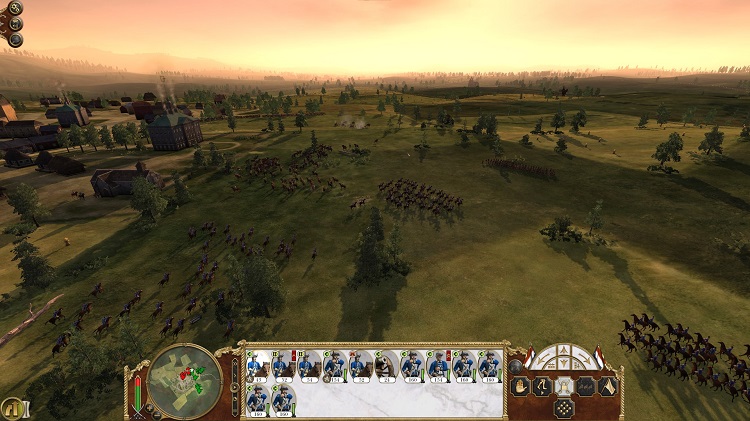
Dutch cavalry push their way closer and closer through squads of Polish cavalry, but are taking considerable casualties from the attrition and artillery fire.
 The Polish cavalry had delayed the regiment of horse for a second reason. An artillery train moving in assistance, mostly the force from Cologne, was partly intercepted by more of the Polish cavalry. As the Dutch infantry managed to catch up to the artillery, they managed to push back the cavalry, but had lost a battery of Howitzers. Behind, the infantry managed to push into position.
The Polish cavalry had delayed the regiment of horse for a second reason. An artillery train moving in assistance, mostly the force from Cologne, was partly intercepted by more of the Polish cavalry. As the Dutch infantry managed to catch up to the artillery, they managed to push back the cavalry, but had lost a battery of Howitzers. Behind, the infantry managed to push into position.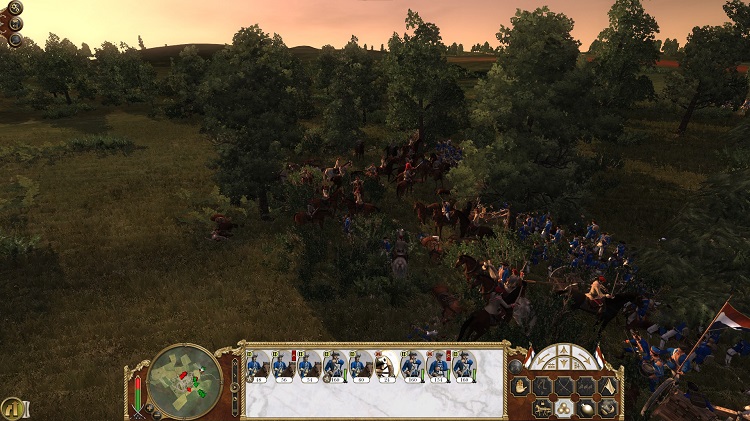
Polish cavalry manage to get into the Dutch artillery before being pushed back by the reinforcing infantry.
 With the Polish cavalry swept from the field, the Dutch managed to push their own cavalry into the light infantry and artillery of the Polish forces leaving only their line infantry. Disorganized, they formed into pockets which were surrounded by two pockets of encircling Dutch infantry, which managed to destroy the last of their adversaries.
With the Polish cavalry swept from the field, the Dutch managed to push their own cavalry into the light infantry and artillery of the Polish forces leaving only their line infantry. Disorganized, they formed into pockets which were surrounded by two pockets of encircling Dutch infantry, which managed to destroy the last of their adversaries.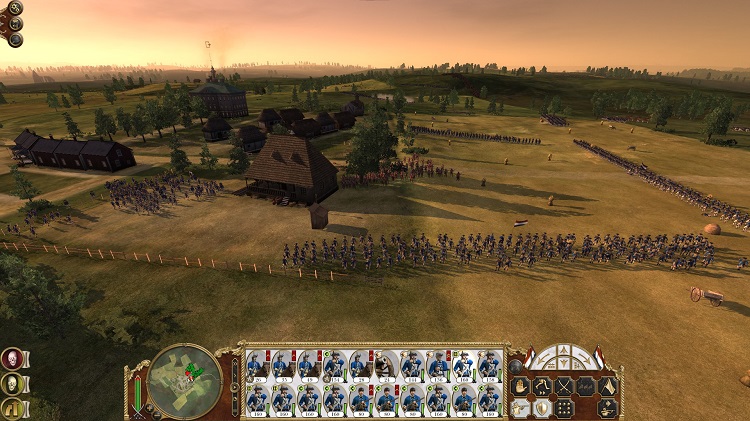
The Dutch surrounding the Polish infantry. The other Polish battalion met a similar fate.
 By the time the smoke had cleared, the Vienna force was free to pass through to Breslau, leaving the Dutch in control of most of the front. Pushing the army forward cut the invading Polish force from their supply, meaning if they did not conquer Munich, they would be in severe trouble as the Dutch could reinforce Munich from Vienna. On the other hand, the Polish forces could not cut off the Dutch invasion route, as they had open lines from multiple provinces.
By the time the smoke had cleared, the Vienna force was free to pass through to Breslau, leaving the Dutch in control of most of the front. Pushing the army forward cut the invading Polish force from their supply, meaning if they did not conquer Munich, they would be in severe trouble as the Dutch could reinforce Munich from Vienna. On the other hand, the Polish forces could not cut off the Dutch invasion route, as they had open lines from multiple provinces. At this time, the Polish were committing their best troops from across the Empire. The majority of the guard were in Prague, while the remainder were assaulting Munich. However, the Dutch were recruiting more infantry of high reputation and discipline to replace the losses of their standard line infantry in the east, while the Polish were replacing their elite forces with far inferior forces. This meant the Dutch were assuming the Polish forces would outmatch them in the early years of the war, but would be overwhelmed when the better equipped and trained men from Amsterdam arrive in Berlin in 1765.
At this time, the Polish were committing their best troops from across the Empire. The majority of the guard were in Prague, while the remainder were assaulting Munich. However, the Dutch were recruiting more infantry of high reputation and discipline to replace the losses of their standard line infantry in the east, while the Polish were replacing their elite forces with far inferior forces. This meant the Dutch were assuming the Polish forces would outmatch them in the early years of the war, but would be overwhelmed when the better equipped and trained men from Amsterdam arrive in Berlin in 1765. Dutch forces in both Breslau and Prague hoped to wait out the Polish, as they had assessed their own forces as inferior. This meant they ran the risk of reinforcements coming from Berlin, Gdansk and Warsaw, but in the event Berlin was evacuated, their forces from Amsterdam could take them through Hannover.
Dutch forces in both Breslau and Prague hoped to wait out the Polish, as they had assessed their own forces as inferior. This meant they ran the risk of reinforcements coming from Berlin, Gdansk and Warsaw, but in the event Berlin was evacuated, their forces from Amsterdam could take them through Hannover. Prussia, confined far to the East could do little of worth, while Hungary and the Ottoman Empire continued their diplomatic struggle, blocking Ottoman intervention against Poland. Of course, the Ottomans were far more invested in their war against Russia. Inversely, Britain was still held in check by the Dutch, and with only a single port which the Prussians controlled from land and sea, the British could not land an invasion without violating the terms of their ceasefire with the Dutch. Alternatively, they could have landed to assist through Polish soil, but as the nation was in a state of crusade, the protestant British forces could not be allowed in Polish soil.
Prussia, confined far to the East could do little of worth, while Hungary and the Ottoman Empire continued their diplomatic struggle, blocking Ottoman intervention against Poland. Of course, the Ottomans were far more invested in their war against Russia. Inversely, Britain was still held in check by the Dutch, and with only a single port which the Prussians controlled from land and sea, the British could not land an invasion without violating the terms of their ceasefire with the Dutch. Alternatively, they could have landed to assist through Polish soil, but as the nation was in a state of crusade, the protestant British forces could not be allowed in Polish soil. To counter the Dutch siege, the Polish forces had attempted to push back the Dutch away from Berlin with a fairly minimal force. While only the first of three army groups destined for Berlin, the Dutch that were present were deemed a reasonable match against the Polish forces. The battle of Magdeburg, initiated by a Polish attack to block the Dutch from entering Berlin was the first to include both the percussion cap shell and the four inch mortar from the Dutch side. These would be pivotal weapons in the battle to come.
To counter the Dutch siege, the Polish forces had attempted to push back the Dutch away from Berlin with a fairly minimal force. While only the first of three army groups destined for Berlin, the Dutch that were present were deemed a reasonable match against the Polish forces. The battle of Magdeburg, initiated by a Polish attack to block the Dutch from entering Berlin was the first to include both the percussion cap shell and the four inch mortar from the Dutch side. These would be pivotal weapons in the battle to come.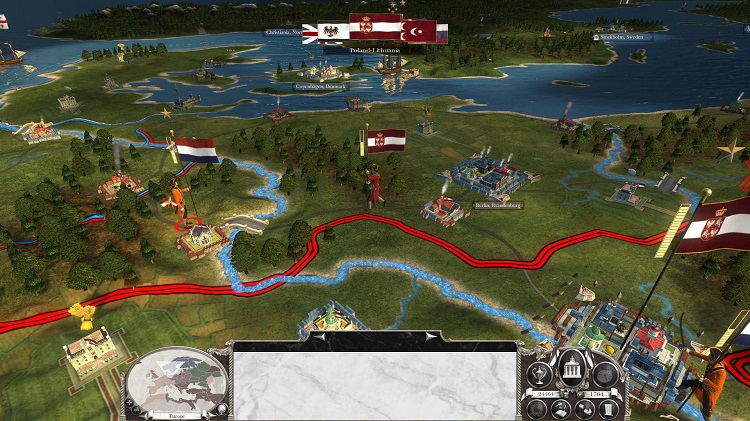
Polish forces move to attack the Dutch around Magdeburg.
 The battle of Magdeburg had occurred a few miles past the Elbe river, as the Polish moved quickly enough to make their crossing before the Dutch could reach the bridge. This meant the Dutch could not push back the Polish at a crossing point to avoid a flanking maneuver from the numerous cavalry the Polish army employed. Establishing themselves on a hill in the countryside hundreds of yards from the Polish lines, the Poles had hoped to check the Dutch advance around Magdeburg to prevent them from advancing further.
The battle of Magdeburg had occurred a few miles past the Elbe river, as the Polish moved quickly enough to make their crossing before the Dutch could reach the bridge. This meant the Dutch could not push back the Polish at a crossing point to avoid a flanking maneuver from the numerous cavalry the Polish army employed. Establishing themselves on a hill in the countryside hundreds of yards from the Polish lines, the Poles had hoped to check the Dutch advance around Magdeburg to prevent them from advancing further. This was to lead to a rude awakening however, as the Polish found themselves being shelled by Dutch artillery. Men with looking glasses could scarcely see the muzzle flash of the artillery being used from impossible distances, and in a panic, the Polish forces advanced on the Dutch, who were strongly set upon their hill.
This was to lead to a rude awakening however, as the Polish found themselves being shelled by Dutch artillery. Men with looking glasses could scarcely see the muzzle flash of the artillery being used from impossible distances, and in a panic, the Polish forces advanced on the Dutch, who were strongly set upon their hill.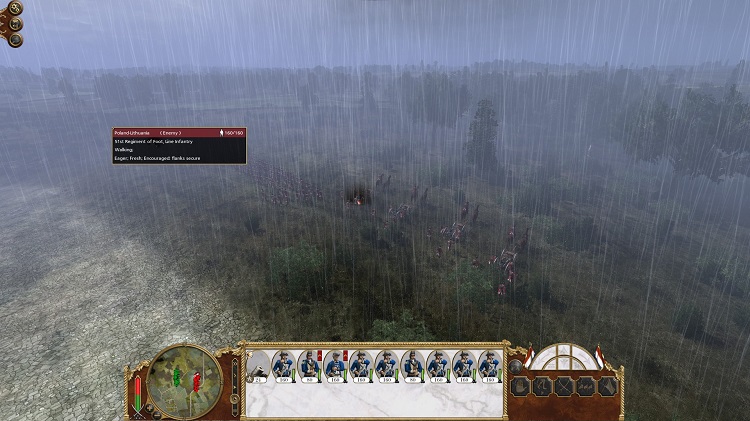
A Dutch explosive shell, well beyond the range the Polish believed possible destroys a howitzer before the Polish had thought battle to be joined.
 In the battle of Magdeburg, the Dutch first wave into Berlin was fairly limited. They had a single mortar battery, nearly a thousand five hundred line infantry, and two battalions of grenadiers. By contrast, the Poles had two howitzer batteries, line infantry and cavalry allowing far greater tactical flexibility.
In the battle of Magdeburg, the Dutch first wave into Berlin was fairly limited. They had a single mortar battery, nearly a thousand five hundred line infantry, and two battalions of grenadiers. By contrast, the Poles had two howitzer batteries, line infantry and cavalry allowing far greater tactical flexibility.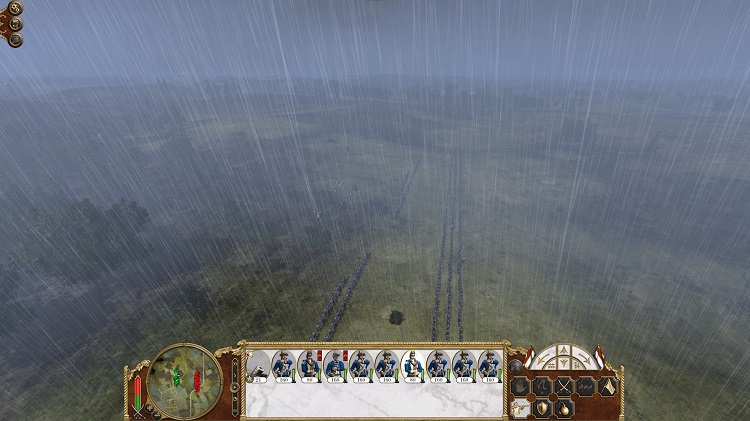
The Dutch line, barely visible. The Dutch forces had no cavalry, they were moving up with the second and third army groups.
 The battle of Magdeburg was fought in an intense rain storm. The Dutch were thankful for their percussion cap shells, as these would detonate more reliably in the rain. The old cord lit fuses were prone to failing in the rain, and the quicklime shells were less deadly when their chemicals were washed away by the shower. Through the rain however, artillery crew were having a more difficult time finding their mark or communicating the results of their shots.
The battle of Magdeburg was fought in an intense rain storm. The Dutch were thankful for their percussion cap shells, as these would detonate more reliably in the rain. The old cord lit fuses were prone to failing in the rain, and the quicklime shells were less deadly when their chemicals were washed away by the shower. Through the rain however, artillery crew were having a more difficult time finding their mark or communicating the results of their shots.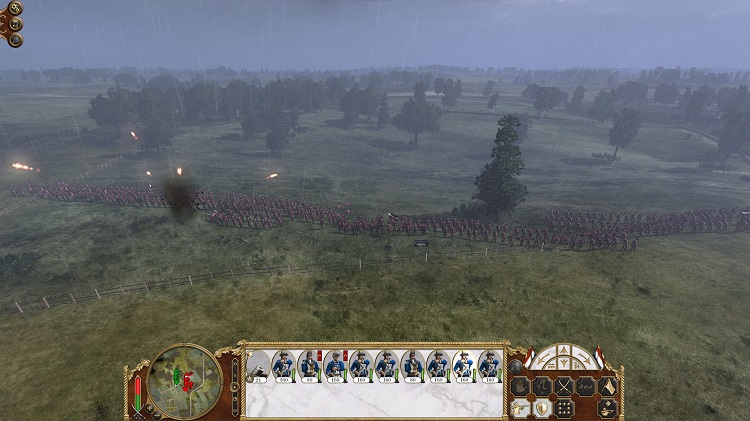
The percussion cap shells were a godsend in the foul weather, and were still performing better than a fuse lit shell would have even in clear weather.
 As the Polish lines organized themselves, the first volley of lucky shells destroyed a howitzer, and another landed right in the midst of a battalion of line, killing many. As the Polish army advanced, their cavalry on the left wing, the Dutch continued to rain their shells down on the line infantry, killing over a hundred on the advance. The slow howitzers had to move gradually up towards the Dutch lines before setting up, but in the intervening time, the Dutch had killed more than their fair share.
As the Polish lines organized themselves, the first volley of lucky shells destroyed a howitzer, and another landed right in the midst of a battalion of line, killing many. As the Polish army advanced, their cavalry on the left wing, the Dutch continued to rain their shells down on the line infantry, killing over a hundred on the advance. The slow howitzers had to move gradually up towards the Dutch lines before setting up, but in the intervening time, the Dutch had killed more than their fair share.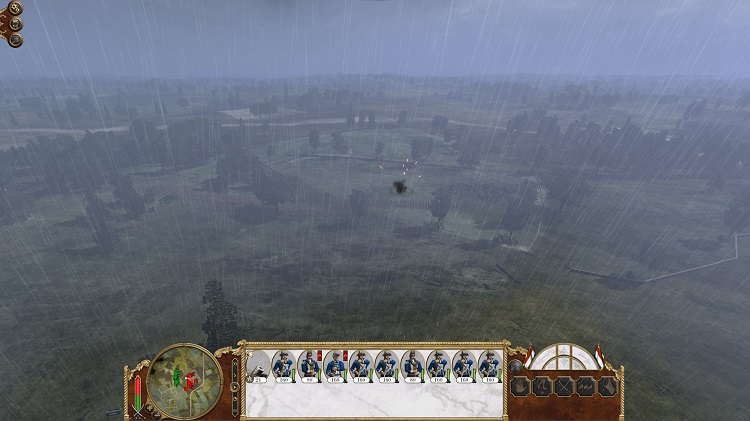
The patter of rain punctuated by the crack of an artillery shell.
 As the Polish lines advanced, they gradually weighted their left flank against the Dutch, granting the Dutch their own left flank in return. The Polish left flank consisted of as many infantry as their Dutch opposition, but also contained the brunt of their cavalry. On the Dutch right, grenadiers were pulled from the center to counter. They were held in reserve, as unlike the percussion cap shells, the grenades could not be reliably used in the rain.
As the Polish lines advanced, they gradually weighted their left flank against the Dutch, granting the Dutch their own left flank in return. The Polish left flank consisted of as many infantry as their Dutch opposition, but also contained the brunt of their cavalry. On the Dutch right, grenadiers were pulled from the center to counter. They were held in reserve, as unlike the percussion cap shells, the grenades could not be reliably used in the rain.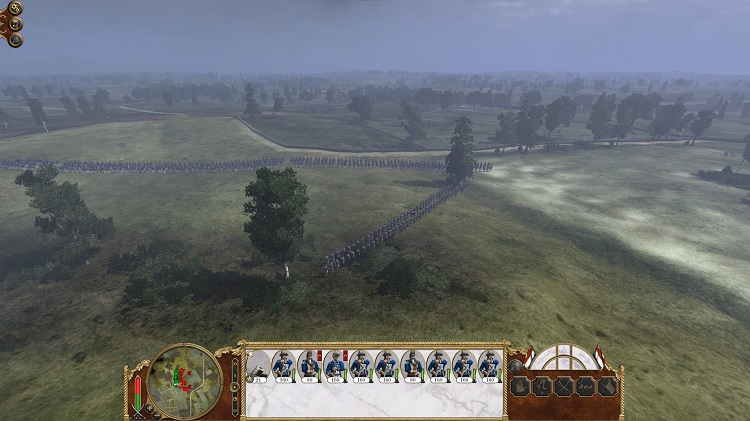
The Dutch moved a grenadier battalion around their right back to prevent a rear charge against their line as the were engaged in a shoot off against the Polish line.
 The Polish force was old fashioned compared to the Dutch army, but not entirely deficient. Their line were directly comparable to the Dutch line infantry, and their cavalry was considered superior. Following a more medieval military doctrine, the Polish employed Uhlans who were armed with spears rather than sabers. This gave them greater ability to use momentum in their favour, and more reach in a clash when fighting other regiments of horse. Of course, that advantage was only considered relevant at the moment of impact, and the saber armed provincial cavalry and regiment of horse were considered superior when forced into a protracted fight.
The Polish force was old fashioned compared to the Dutch army, but not entirely deficient. Their line were directly comparable to the Dutch line infantry, and their cavalry was considered superior. Following a more medieval military doctrine, the Polish employed Uhlans who were armed with spears rather than sabers. This gave them greater ability to use momentum in their favour, and more reach in a clash when fighting other regiments of horse. Of course, that advantage was only considered relevant at the moment of impact, and the saber armed provincial cavalry and regiment of horse were considered superior when forced into a protracted fight. 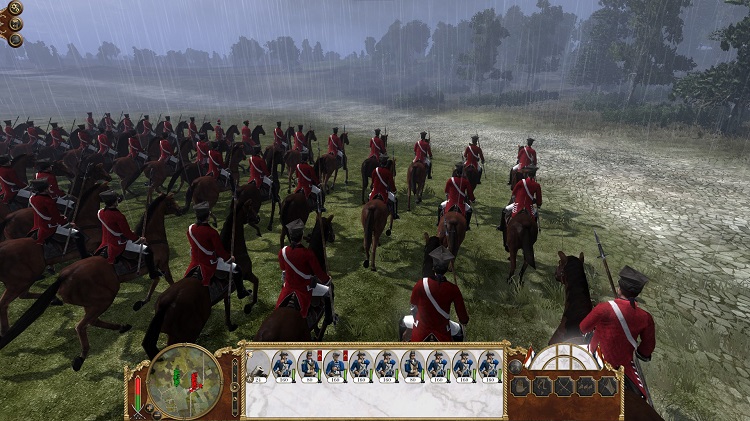
Polish lancers. Based around an older style of fighting, they discarded the armour of a traditional knight. This let them achieve their objective faster, meaning they would take less fire.
 As the Polish were advancing line as well as horse along the far right, the Dutch could not afford to form square to hold off the Polish charge, as the line infantry were within firing range. However, as the Polish forces had struggled their way up the hill, rain had lifted to a light drizzle, and so the reserve grenadiers managed to blow apart the assault with their grenades.
As the Polish were advancing line as well as horse along the far right, the Dutch could not afford to form square to hold off the Polish charge, as the line infantry were within firing range. However, as the Polish forces had struggled their way up the hill, rain had lifted to a light drizzle, and so the reserve grenadiers managed to blow apart the assault with their grenades.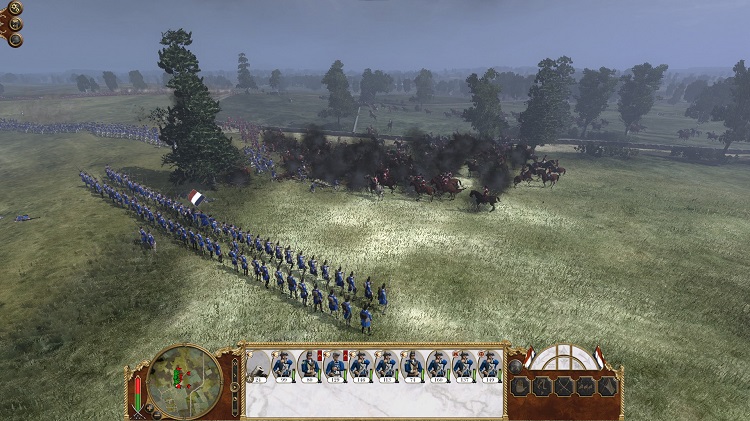
The weather had cleared just in time for the grenadiers to get their work done. The assault by grenade immediately equalized the Dutch right flank.
 In the center, a similar infantry charge up into Dutch lines met a similar fate as the second reserve battalion showered them with shrapnel, followed up by a charge. Severely softened by the time they made contact, both by grenade attacks, musket fire and constant artillery bombardment, the Polish forces were rapidly pushed from the field.
In the center, a similar infantry charge up into Dutch lines met a similar fate as the second reserve battalion showered them with shrapnel, followed up by a charge. Severely softened by the time they made contact, both by grenade attacks, musket fire and constant artillery bombardment, the Polish forces were rapidly pushed from the field.
A grenadier, often one of the tallest soldiers on the field, could throw a grenade well over an ally's head to reach the enemy beyond. They needed a strong throwing arm however, as shortfall was disastrous.
 The Dutch had won Magdeburg, and with it, a free pathway to Berlin. With two reinforcing army groups directly behind them, the Dutch were almost guaranteed to capture their ally’s former capital. This also insured that the Polish garrison from Berlin could not lift the siege of Dresden, forcing them into a more radical defense. Directly assaulting the Dutch lines around Prague, the Polish army hoped to break through before turning their garrison north to relieve Dresden. South, their army moved to assault the Dutch in Munich, hoping to destroy them before any further reinforcements could be sent.
The Dutch had won Magdeburg, and with it, a free pathway to Berlin. With two reinforcing army groups directly behind them, the Dutch were almost guaranteed to capture their ally’s former capital. This also insured that the Polish garrison from Berlin could not lift the siege of Dresden, forcing them into a more radical defense. Directly assaulting the Dutch lines around Prague, the Polish army hoped to break through before turning their garrison north to relieve Dresden. South, their army moved to assault the Dutch in Munich, hoping to destroy them before any further reinforcements could be sent. The battle of Prague involved a thousand more Dutch soldiers than Polish forces, but the Polish force had their elite guard. House cavalry were capable of feats of bravery and martial prowess unmatched by most battalions, and when they managed to earn a melee battle without having losses to musket fire, they could easily batter aside formations of lesser men. Of course when they were fired upon, they were no more resilient than any other men, and even they could not defeat a square. Their ability to outright defeat infantry rather than simply tie them up however made them deadly.
The battle of Prague involved a thousand more Dutch soldiers than Polish forces, but the Polish force had their elite guard. House cavalry were capable of feats of bravery and martial prowess unmatched by most battalions, and when they managed to earn a melee battle without having losses to musket fire, they could easily batter aside formations of lesser men. Of course when they were fired upon, they were no more resilient than any other men, and even they could not defeat a square. Their ability to outright defeat infantry rather than simply tie them up however made them deadly. Ferdinand Strijders was the replacement for General Schafter. A younger man, and once again of limited experience, Strijders was sent to the front of the first wave while a more suitable candidate was found to lead the main thrust into Warsaw. The Dutch had tried to appeal to the aged General Vrooman in Florida, but it was clear he was too old and ill to contribute much more. His mind had not dimmed, but his heart was failing him. If a suitable general could not be found, they had even considered bringing Schafter back in to service from Cologne. At the very least he would prove well experienced in the arts of bloodshed.
Ferdinand Strijders was the replacement for General Schafter. A younger man, and once again of limited experience, Strijders was sent to the front of the first wave while a more suitable candidate was found to lead the main thrust into Warsaw. The Dutch had tried to appeal to the aged General Vrooman in Florida, but it was clear he was too old and ill to contribute much more. His mind had not dimmed, but his heart was failing him. If a suitable general could not be found, they had even considered bringing Schafter back in to service from Cologne. At the very least he would prove well experienced in the arts of bloodshed.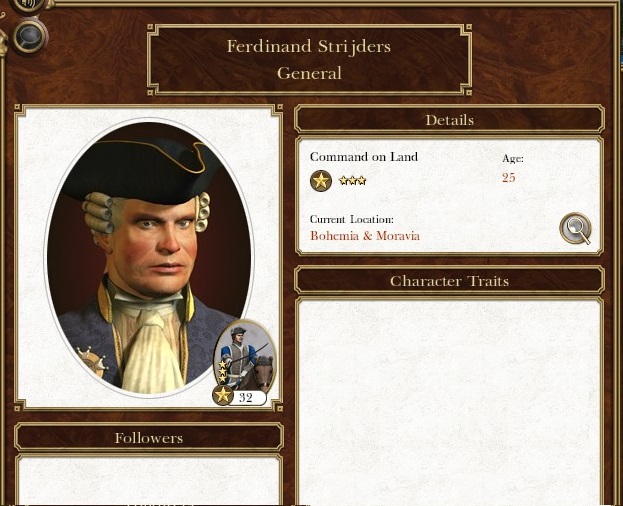
Strijders in his white powdered wig. As he was only 25, his natural hair was actually dark black, but he did not wish to appear youthful.
 Ferdinand Strijders had been a colonel of the horse in the invasion of Italy, and had shown moderate talent of command during the invasion. Despite this, he had not done much in terms of command while in Italy, as cavalry was often formed in either part regiments or were not used extensively in battle, existing only to mop up remaining forces. The Dutch were assessing candidates from the battle in London, but so few had survived that were not somehow touched in the head that they were often considered poor candidates. This wouldn’t be the first mad dog general in history however, and it certainly couldn’t have harmed their efforts.
Ferdinand Strijders had been a colonel of the horse in the invasion of Italy, and had shown moderate talent of command during the invasion. Despite this, he had not done much in terms of command while in Italy, as cavalry was often formed in either part regiments or were not used extensively in battle, existing only to mop up remaining forces. The Dutch were assessing candidates from the battle in London, but so few had survived that were not somehow touched in the head that they were often considered poor candidates. This wouldn’t be the first mad dog general in history however, and it certainly couldn’t have harmed their efforts. Strijders however, would prove himself far more courageous than others had anticipated in his defense at Prague. With his forces split to manage both defending the garrison and assaulting the forces stationed outside the Polish walls, Strijders would need to use every ounce of his military cunning to come out on top.
Strijders however, would prove himself far more courageous than others had anticipated in his defense at Prague. With his forces split to manage both defending the garrison and assaulting the forces stationed outside the Polish walls, Strijders would need to use every ounce of his military cunning to come out on top. Next we will be presenting popular, local spring flowers followed by world news. If you want news of the current war in the Middle East please channel in to BBC radio 1. David Stephenson will be presenting more on the 80 years war in 3 days.
Next we will be presenting popular, local spring flowers followed by world news. If you want news of the current war in the Middle East please channel in to BBC radio 1. David Stephenson will be presenting more on the 80 years war in 3 days.